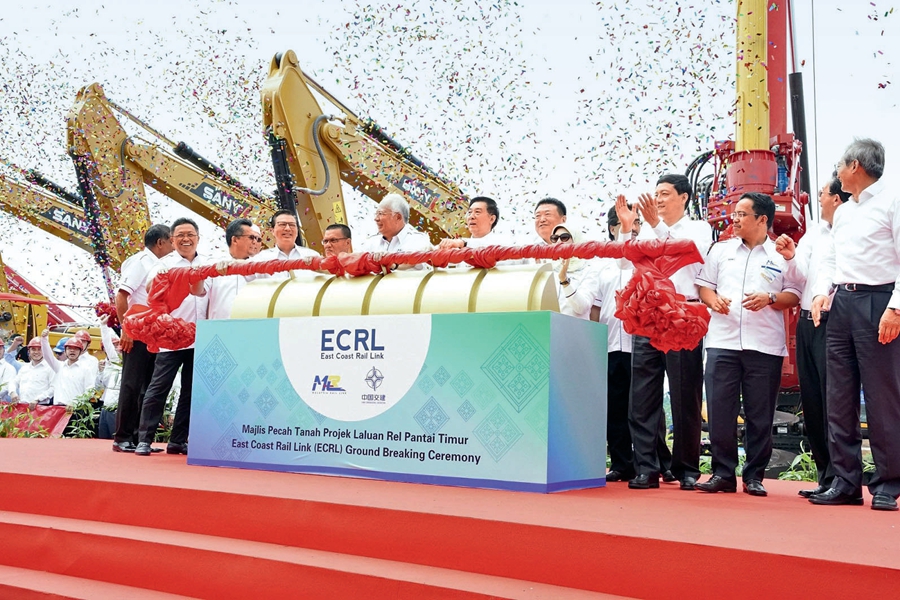By YASIR HABIB KHAN
By YASIR HABIB KHAN
SINCE South Asian Association for Regional Cooperation (SAARC) and Association of Southeast Asian Nations (ASEAN) countries are becoming the largest recipients of economic leverage unleashed by China over the last few years, a flurry of financial, trade, and infrastructure fortunes pour into both regions. This augurs well for South Asia (SA) and Southeast Asia (SEA) to channelize their development growth and blossom into leading economies of the world.
Judging their upswing progress trajectory, international monetary and financial institutions label both SA and SEA as fastest-expanding economies, giving credit to China’s deepening market-oriented footprint in these regions. Internationally known credit rating agency Moody’s has said that the Belt and Road Initiative begets more positive than negative effects both for China and the recipient countries.

The groundbreaking ceremony of the East Coast Rail Link in Malaysia is held on August 8, 2017. It is one of the most invested projects of the Belt and Road Initiative.
Some years ago, SAARC and ASEAN countries were underperforming, economically cash-strapped, financially poor with sketchy trade, communication, and IT infrastructure. In an unsavory situation, it seemed like a lost cause to divert investment and resources to these feeble countries.
The West made a mockery of China for selecting the area for extensive business joint ventures and huge investments. Shrugging off qualms and negative propaganda, China teamed up with them to grow mutually, sharing a bonanza of incredible success.
In order to rejuvenate ASEAN, China has increased flow of foreign direct investment (FDI) into the region. The U.S., Japan, and Europe have historically sunk in a massive chunk of FDI into ASEAN, but China has now changed the equation.
United Overseas Bank (Malaysia) Bhd believes that stock of FDI accumulation in ASEAN has been swelling at the rate of 15 percent. It is expected that FDI flows into ASEAN will gain further momentum and will triple to US $5.2 trillion in 2030, from estimates of US $1.8 trillion in 2015. The implementation of the ASEAN Economic Community is also a step towards closer cooperation among ASEAN economies.
China-driven growth has ushered in an economic boom in ASEAN members. Growth rates of more than six percent reflect the pace of development in the Philippines and Vietnam. The World Economic Forum foresees that with a combined population of more than 620 million and economic size of US $2.6 trillion, the region has full potential to be the world’s fifth largest economy by 2020.
The epic Belt & Road Initiative is proving to be the icing on the cake in the robust growth of ASEAN. Projects of a new high-speed rail line that runs from southern China through Laos to Thailand’s industrial east coast, along with rail projects in Laos, Indonesia, and Thailand will catalyze regional integration and progress.
Similarly being a beneficiary of China-led investment and infrastructure projects, SAARC countries are gearing up to be new driving engines for global economic growth in South Asia. China’s investments in South Asian countries, including Sri Lanka, Pakistan, and India have risen to more than US $12.29 billion and regional trade jumped to over US $111 billion. China, the largest lender to Sri Lanka, also pumped over US $7 billion in the island nation.
Pakistan’s trade volume with China has amounted to more than US $15 billion during the last fiscal year, and it has potential to grow to US $45 billion – only one percent of China’s total trade – through connecting underdeveloped regions with the China-Pakistan economic corridor.
With US $10 billion in total trade volume between China and Nepal, business activities are increasing at a rate of 39 percent per annum. Business is expected to get a boost from the new policy outlook of the ambitious Belt and Road Initiative and its associated investment in infrastructure. During the March 2017 post-earthquake investment summit in Kathmandu, representatives of 89 Chinese firms participated – the largest delegation of all – and committed US $8.3 billion in investments to different sectors. Beijing-based Asian Infrastructure Investment Bank (AIIB) announced at the summit that Nepal would receive loans from the bank starting in 2018.
China now is the biggest trading partner of Bangladesh. Chinese companies’ engineering, procurement, and construction contract volume in the first 10 months of 2017 increased 24.1 percent year-on-year to US $6.4 billion. As announced on the Belt and Road Forum for International Cooperation held in May 2017, China will host the first China International Import Expo (CIIE) in Shanghai in November 2018. It is estimated that 150,000 professional buyers will come to attend the CIIE. Bangladeshi enterprises are more than welcome to attend the CIIE and share the benefits brought about by China’s economic growth.
China’s long-term investment commitment towards South Asia and ASEAN is highly likely to reap benefits of the tremendous economic potential for all parties involved. The region’s connectivity to the rest of the world will be vastly broadened, on the back of planned major infrastructure projects. This, together with the spread of Chinese companies’ clout in SAARC and ASEAN will bring enormous employment opportunities for the latter. More importantly, both regions will have access to much needed financing and expertise which were previously deficient.
To top it all, China’s economic growth vibes will help both SAARC and ASEAN to be self-reliant financially, economically, and improve living standards of their people by heralding a new era of shared prosperity, peace, and progress.
YASIR HABIB KHAN is a senior journalist writing about the economy, diplomacy, international relations, governance, and environment. He is a fellow of the International Center for Journalist (ICFJ).